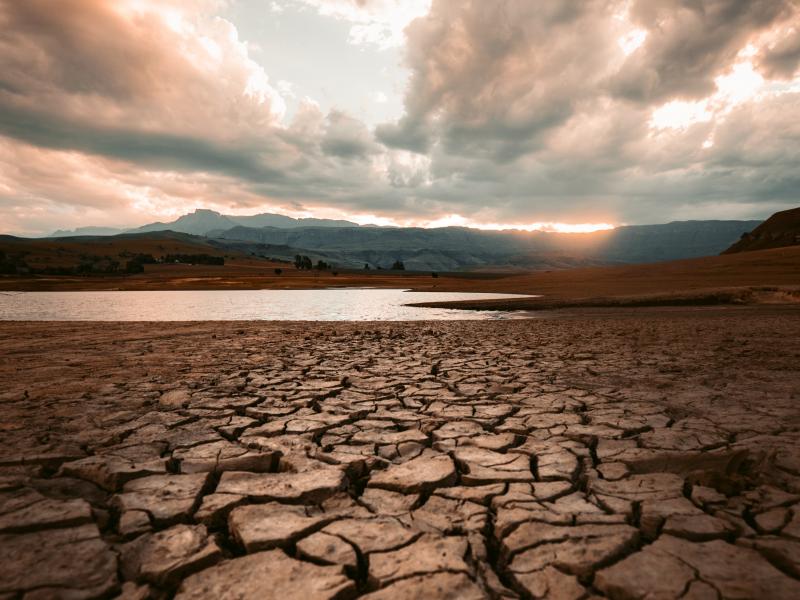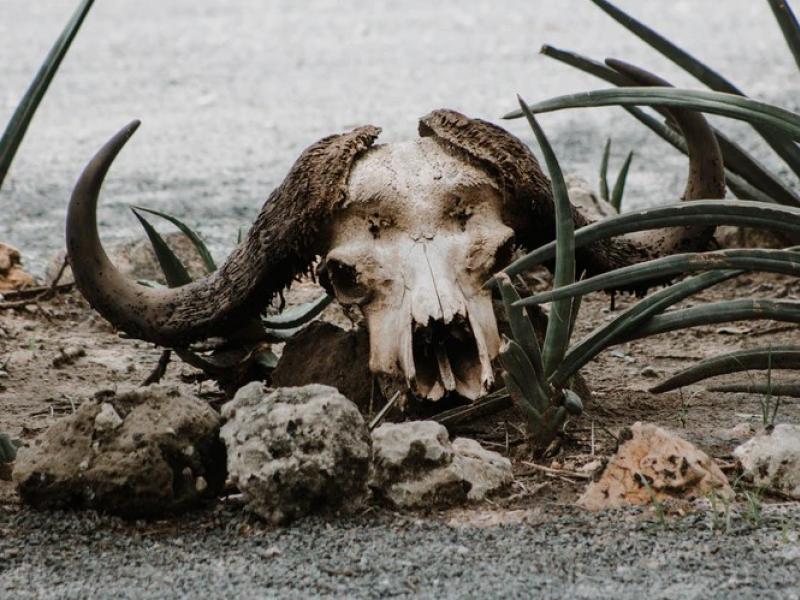Which Waste Land?
Máighréad Medbh takes us on a journey through T.S. Eliot’s epic poem ‘The Waste Land’ and points to the significance and benefits of reading it during the Covid-19 pandemic.
‘The Waste Land’ by T. S. Eliot has been attracting attention lately for its symbolic connection to the pandemic. The poem is generally described as having been written during the poet’s recovery from the Spanish ’flu, which he contracted in 1919. The ’flu tended to affect the central nervous system. If you recovered from its many other harrowing symptoms, you were liable to depression and various kinds of mental alterations, to the point of suicide in some cases. Eliot had a mild version, but was said to have been greatly weakened by it.(1)
This is not the full story. Neither the pandemic nor its conflation with the extreme experience of World War I (a kind of unreality for Eliot) fully set the scene for the poem. As with everything else, sources are great, small and multifarious.
"[Eliot] wrote to Middleton Murry in 1925 . . . 'I have deliberately killed my senses—I have deliberately died—in order to go on with the outward form of living—This I did in 1915.' This was the year, of course, when Eliot had married Vivien.(2")
Late in 1921, Eliot was granted three months leave of absence from his work in Lloyd’s Bank because of “mental exhaustion,” a state described by his wife and Ezra Pound as a breakdown.(3) The poem had been in his mind for almost a year before this, according to his letters, and he managed to complete a full draft while convalescing in Margate and Lausanne.
Eliot agreed with a comment in 1922 that ‘The Waste Land’ spoke for “the starvation of a whole generation,” while suggesting also that one might over-read the poem.(4) In the 1930s he described it as “the relief of a personal and wholly insignificant grouse against life.”(5) In a letter to his brother in 1936, he elaborated on his state of mind at the time of writing, emphasising “the horrors of my private life,” his sense of guilt at “having married a woman I detested,” and her constant criticisms.(6)
The state of a poet’s private life isn’t normally a major issue. The poet is a crafter and in the writing the poem establishes itself as something separate. I’m interested in the life here because it seems to me that, for all its inter-textuality, Eliot’s biographical presence is crucial to the content. That’s not to say that his “personal grouse” and other self-deprecating remarks should be taken seriously. The poem is the work of a scholar of philosophy, literature and language, whose technical attention was extraordinary, such that he accepted most of Ezra Pound’s suggestions and reduced the original draft by almost half.(7)
In his own notes to ‘The Waste Land,’ Eliot attributed the title, the plan and “a good deal of the incidental symbolism” to the influence of Jessie L. Weston’s book on the grail legend, From Ritual to Romance. In her book, Jessie Weston traces the genealogy of the medieval quest for the “Holy Grail” to ancient fertility cults, Babylonian, Aryan, Classical, and worldwide. At the centre of these was the theme of a Waste Land needing to be restored by the correct actions of a hero who is in some way outside normal history. There’s a fertility god or king, identified with the land, who is wounded or absent. The resurrection of this god-king is crucial to the restoration of fertility. Water is important, rain and rivers. The imprisonment of the rivers in the Indian Rig-Veda is compared with similar halting and freeing of waters in medieval quest texts. The Sumerian-Babylonian texts addressed to Tammuz, “god of the nether sea,” were in the form of wailings or lamentations, seeking the restoration of the fields, forests and palaces, of life at its perceived best.(8)
At the centre of Eliot’s poem then, we have the wounded fisher-king of the grail legend, conflated with his previous avatars. Wounded, significantly, in the thigh, the poem-king laments that he is dead in life. We must see the Thames as standing for an ailing Tigris or Ganga, with its bridge-traffic of living dead:
"A crowd flowed over London Bridge, so many,
I had not thought death had undone so many."
(I: 60-61)
Thames is also Rhine, accompanied by Wagner’s lamenting Rhine-maidens (III). The poem repeatedly mentions drought but it’s a symbolic lack—of life itself to some degree, but mostly of meaning—as expressed in the shallowness and anxiety of conversations and mores, the typist’s arid routine.
Conflated with the fisher-king is Phlebas, a kind of symbolic drowned everyman, and Tiresias who, according to Ovid’s Metamorphoses, lived as both man and woman and was blinded by Juno for betraying the fact that women had more physical pleasure than men.(9) It’s hard not to see as the fourth point of this male ambivalence Eliot himself, married without love and with hardly any experience of women, locked in his “deliberate death.”
Of the four, only Tiresias speaks directly: “I Tiresias, old man with wrinkled dugs / Perceived the scene, and foretold the rest . . .” (III: 228-9). Otherwise the voices are of the given cultural world. They span history and context. They do indeed represent life-as-we-know/knew-it. The poem is a rebirth in itself with its stunningly new approach to composition—its compositeness, its representation of selfness without egotism. Self is formed by the voices of others.
The poem’s narrative, if it can be called such, appears to proceed from voice to voice, quoting a wide range of writers. Dante is important, Conrad is important, Baudelaire is important, but they are interwoven with many others. It’s surprising then that in 1939 Eliot implied that it was written for one voice.(10) There may be a clue to what he means in his Notes, where he says that all the women are one woman and the two sexes meet in Tiresias, the most important personage in the poem. We might therefore see-hear the narrator as disembodied, entering various avatars for periods, inhabiting none.
"The progress of an artist is a continual self-sacrifice, a continual extinction of personality . . ."(11)
The structure is ritualised, with the lament clear but relieved by the variety of utterance and tone. Vedic practice is important to the form and thrust. The fifth and final section is called “What the Thunder Said,” and refers to the fable of the meaning of the Thunder in the Great Forest Upanishad. Eliot said that this section was written in one sitting and not revised.(12) What the Thunder said was Datta, Dayadhvam, Damyata—Give, Sympathise, Control. Then, I suppose, comes the fructifying rain.
I recommend The Poems of T. S. Eliot: The Annotated Text (Vol. I), edited by Christopher Ricks and Jim McCue, for its staggering 159 pages of notes on ‘The Waste Land’ alone, where I found most of my information. I recommend the poem for reading alongside Covid-19. It will send you travelling without the need for masks or distancing. It will keep you engaged tracking the sources and tributaries, the many selves the poet has managed to unify.
In 1931 Eliot wrote: “. . . it is a commonplace that certain forms of illness are extremely favourable, not only to religious illumination, but to artistic and literary composition. A piece of writing meditated, apparently without progress, for months or years, may suddenly take shape and word . . . he to whom this happens assuredly has the sense of being a vehicle rather than a maker . . . You may call it communication with the Divine, or you may call it a temporary crystallization of the mind.”(13)
Mind / Divine—the words we use are crucial. There’s an echo here of Hermann Hesse, whom Eliot read:
"A prophet is a sick man, like Dostoevsky, who was an epileptic. A prophet is the sort of sick man who has lost the sound sense of taking care of himself, the sense which is the saving of the efficient citizen. It would not do if there were many such, for the world would go to pieces. This sort of sick man, be he called Dostoevsky or Karamazov, has that strange, occult, godlike faculty, the possibility of which the Asiatic venerates in every maniac. He is a seer and an oracle. A people, a period, a country, a continent has fashioned out of its corpus an organ, a sensory instrument of infinite sensitiveness, a very rare and delicate organ."(14)
An idealistic view, but—of all genders—sometimes seeming true. The touch of Tiresias.
Footnotes
-
Outka, Elizabeth. ‘“Wood for the Coffins Ran Out”: Modernism and the Shadowed Afterlife of the Influenza Pandemic.’ Modernism/modernity 21, no. 4 (2014). https://muse.jhu.edu/article/566471
-
Banerjee, A. “T. S. Eliot’s Doomed Marriage.” Sewanee Review, vol. 124 no. 1, 2016. https://muse.jhu.edu/article/612445
-
The Poems of T. S. Eliot: The Annotated Text, Volume I. Edited by Christopher Ricks and Jim McCue, 547-550. The war: “I have signed a cheque for £200,000 while bombs fell about me . . . it all seems like a dream.” 657.
-
Ibid., 573.
-
Ibid., 577.
-
Ibid., 578.
-
Ibid., 580.
-
From Ritual to Romance. Okitoks Press, 2017. (Originally published 1920. Available in various editions and formats.)
-
Metamorphoses, III: 316-338. https://ovid.lib.virginia.edu/trans/Metamorph3.htm#476975711
-
Ibid., 662.
-
Tradition and the Individual Talent. Quoted Annotated Text, 701.
-
Annotated Text, 686, 699.
-
Ibid., 686-7.
-
“The Brothers Karamazov or The Downfall of Europe.” Translated by Stephen Hudson (a pseudonym of Sydney Schiff). The Dial magazine. New York, volume 72.6 (June 1922) (Republished in A Glimpse into Chaos). http://world.std.com/~raparker/exploring/tseliot/people/hesse.html

